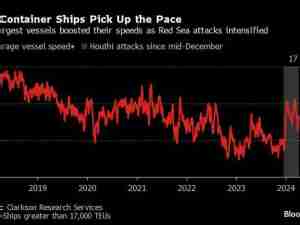As the performance of the US import market continues at unprecedented levels, Maersk will aim to provide an update on the different supply chain developments on a more frequent basis. The goal is to provide its customers with the most relevant information in order to assist them in making the right Supply Chain decisions in a volatile market. Latest update below:
Key Notes on the Pacific Trade
Equipment availability to become one of the potential key bottlenecks
- Demand from Asia continues to be very strong, impacting vessel schedule-reliability across all networks; further exacerbated by increased wait-times for vessel berthing in the US ports.
- Equipment shortage remains an industry-wide challenge and has become the limiting factor for exports out of Asia at this point. Significant shortages are expected up until Lunar New Year.
- Equipment Returns have become a critical lever in maintaining the flow of the global Supply Chain. We are proactively working with all of our Customers to return empty import equipment as quickly as possible. Your Asia imports depend on it.
- Blank sailings have been announced across various trades in the market, likely triggered by vessels sliding due to delays resulting from congestion. We expect port-delay induced blank sailings to increase, not by Carrier choice, but by lack of available vessels or equipment.
- Duration. Based on the above-mentioned trends, we expect some of the current challenges to push into Q1 of 2021. Steps are being taken to prepare for the upcoming Lunar New Year with this in mind.
- Your forecasts are of vital importance. Please be sure to continue to share your January and February 2021 expectations to allow for our optimal and proactive planning for the months ahead.
High dwells on import containers in the US continue to impact future availability of container equipment in both Asia and the US – especially since future demand expectations are stronger than originally expected. We encourage our customers to take delivery of containers and return empty equipment as swiftly as possible.
A steady rhythm of returns is of paramount importance for both the import flows from Asia as well as the export flows from the US. We are working closely with our Customers to ensure optimal positioning of our equipment and allow the appropriate demand on US exports to be sufficiently supported across our network. This will require a persistent focus across Carriers and Shippers over the next weeks until Lunar New Year.
Supply Chain agility recommended as Peak Season blends into Lunar New year
Increasing the collaboration across all international and domestic departments within your supply chain is a must as this peak season begins to coincide with Lunar New Year preparations. Remain vigilant with placing data at the center of all conversations to review changing market demands and look at contingency purchase order planning to leverage the dynamic flow of replenishment vs. seasonal/special buy merchandise. It is recommended to coordinate manufacturing outputs with all your suppliers. The idea is to review not only unit creation & speed off the production lines but origin source logistics (stuffing windows, locally-sourced trucking power, documentation support) to ensure you can capitalize on smoothing out previous year surges to stabilize inbound cargo flow.
Port Operations Update
PNW:
Prince Rupert Terminal
Vancouver/Centerm
Southern California
- Vessel wait times continue at 4 – 5 days.
- Yard capacity exceeds 100%, using overflow areas to accommodate.
- Labor: Using maximum gangs on the rail to maintain yard fluidity and five gangs on vessels to balance cargo flow.
- Vessel wait times reman at 4 – 5 days.
- Yard capacity increased to 87%.
As the ports of LA/LB manage the peak of Peak Season 2020, industry stakeholders are looking ahead to Thanksgiving Thursday, November 26 which is a no-work holiday for the ILWU. Terminals reopen on Friday, Nov. 27. Many Americans will commence an extended weekend on Wednesday, Nov 25.
The industry will monitor the supply of dockworkers, truck drivers, warehouse workers and railroad crews over the five-day holiday. The supply chain resumes normal operations on Monday the 30th, to chip away at the backlog of import cargo. While there are reports of vessels at anchor harbor-wide, Maersk vessels are not impacted by this. (Daily average continues to be around 10 -1 2 vessels at anchor)
Missed truck appointments: Throughout the LA/LB harbor, we see a high number of missed truck appointments. We encourage customers to work with their trucking partners to cancel any import or empty appointments that will not be used to free them up for more urgent freight deliveries.
APM Terminals Pier 400 Los Angeles
TTI Long Beach
Landside Transportation
- Vessels at anchor: None.
- Vessels alongside: Experiencing extended port stays between 3 - 4 days.
- Yard utilization: 85%
- Import dwell average 6-7 days
- Gates: Pier 400 will offer a Friday night gate, Nov 27th (6:00 pm – 3:00 am PST), and a Saturday gate, November 28th this week. Gates will be closed Thursday November 26th for the Thanksgiving holiday.
- Import Yard utilization continues to be high and we encourage customers to prioritize picking up cargo. 2nd shift appointments particularly on Thursday and Friday and Saturday have the most availability for customers looking for appointments.
- Vessels at anchor: None.
- Vessels alongside: Experiencing extended port stays between 1 – 3 days.
- Yard utilization: 52%
- Import dwell average: 5.5 days
- Gates: TTI will offer a second shift gate 6:00 pm – 3:00 am PST on Fridays and a Saturday day gate during Peak Season.
- All gates will be closed Thursday November 26th for the Thanksgiving Holiday.
- Empty returns: TTI offers empty exemption appointments on dual transactions.
Trucking shortage:
Capacity from major truckloads is completely utilized, with California broker boards showing one truck available for every 12 loads, and nationally - one truck available for every seven loads. Further disrupting delivery times and creating a chassis shortage, users in California are holding onto containers/chassis an average of 7.4 days — double the normal dwell time. Customers are encouraged to return chassis and containers as quickly as possible to ensure continued flow.
Store-Door Trucking Update
Overall in Southern California, dwells for store-door trucking and the volume of store-door containers with high dwells are showing improvement. However, trucking capacity, appointment availability, and chassis in Los Angeles and Long Beach market remain extremely tight and we continue to work closely with our providers to ensure cargo moves as quickly as is possible. Consistent internal communication between Maersk teams is being conducted to ensure alignment, which further allows us to do our best in keeping cargo flowing within the current environment.
Having appointments at the terminals scheduled as early as possible, for both imports and empty returns, is very important in avoiding unnecessary delays. Additionally, working to have shipments fully Customs-cleared prior to discharge helps in cargo flowing more smoothly.
Rail Services
With continued high volumes flowing through United States and Canada west coast gateways, the rail network is still holistically challenged, but continues to remain fluid.
Vendors are working hard to continue maximizing operations, as well as maintain network train speeds and schedule reliability. Chassis shortages and longer-dwelling containers continue to result in higher ramp congestion.
Due to the resulting reduced space, many inland ramps are still being forced to place restrictions on the volume of traffic they can accept daily or move through specific ramps. This assists in ensuring cargo can move timely and, as ramps clear, restrictions are lifted or eased to allow acceptance of additional cargo.
Overall, to aid in minimizing congestion, customers are requested to please take possession of containers arriving via rail as soon as is possible.
Canada (Vancouver Centerm and Prince Rupert)
Overall, the Western Canadian gateways continue to see high yard utilization. On-dock rail dwell times remain elevated in both Vancouver and Prince Rupert. For Vancouver, average rail dwell currently sits at 6.8 days, with Prince Rupert at 5.2 days. It is important to note that, unrelated to peak volumes, Vancouver dwell was also impacted this week by two separate operational work stoppages, resulting in two lost shifts of rail work. Rail car supply continues to remain consistent to maximize the on-dock rail programs.
United States (Long Beach Pier T and Los Angeles Pier 400)
Long Beach Pier T and Los Angeles Pier 400 continue to work diligently on minimizing impact to customers. With the increased volume, on-dock rail dwells remain slightly elevated. However, rail car supply remains consistent, helping to maintain on-dock rail programs and limit rail dwell time of import loads.
Local off-dock rail ramp connections are experiencing delays as a result of reduced chassis and trucking capacity. For cargo that is currently routed to United States west coast ports for local trucking delivery, please note that we are happy to help with finding alternative inland rail or long-haul trucking solutions where operationally feasible. Please let us know if we can assist in any way with helping to find solutions.







